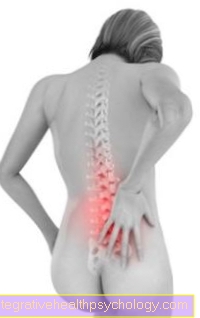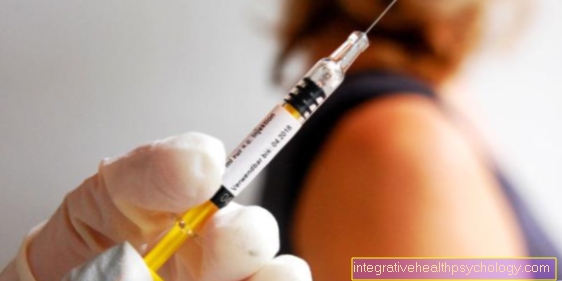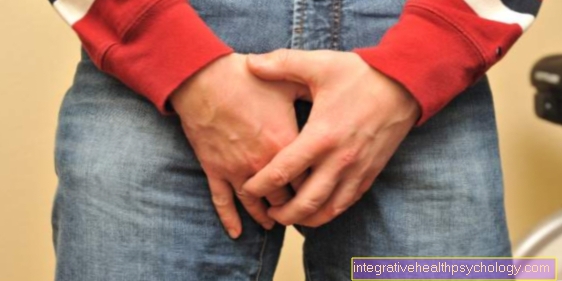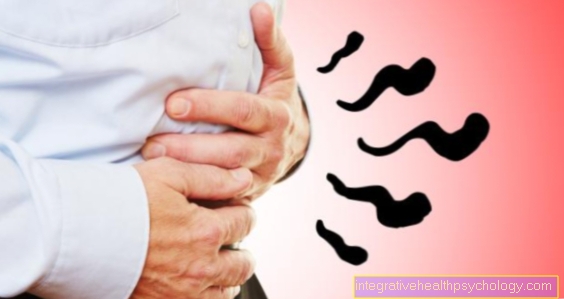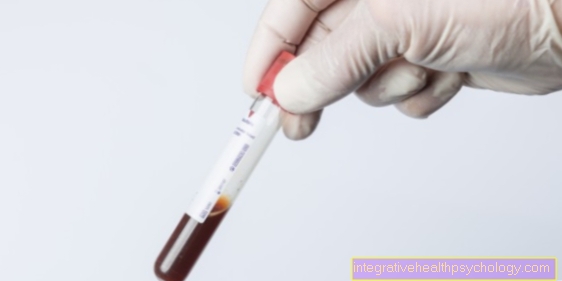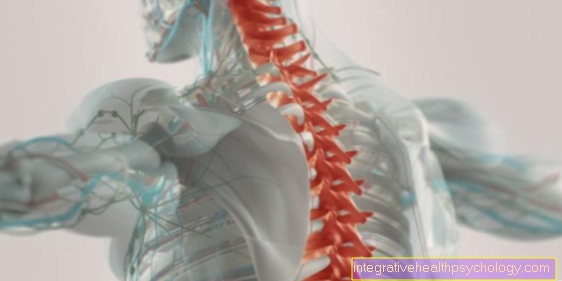Bruise of the finger
definition
Bruises, called contusions, are caused by the action of blunt force on soft tissues. The tissue is crushed, which injures vessels. Leakage of lymph and blood leads to bruising and swelling.
Superficial skin injuries are usually absent, severe pain occurs, which can worsen with exercise. The hand or fingers can also be bruised, typically the patient takes a relieving posture and is in pain. In addition, swelling and bruising can occur.

causes
The cause of a bruise is that Exposure to blunt force. Finger bruises often arise in the Framework of sportsthat involve frequent body contact or falls.
In ball sports, the violent impact of balls on the fingers leads to bruises, among other things. Sports should be mentioned here like Handball, basketball or volleyball. Falls are also part of many sports, especially falls from great heights such as in horse riding or Climb can lead to bruises. Also kicks, blows or bumps that affect the hand and fingers such as for example Martial arts can lead to bruises.
diagnosis
The suspected diagnosis of bruising can already be made based on the patient interview and the description of the course of the accident. A large number of differential diagnoses must be excluded.
X-rays can be used to identify possible broken bones.
Other radiological measures can assess the injury to soft tissues such as muscles, tendons, or capsules.
A finger bruise can bleed into joint capsules. If there are bruises in addition to severe pain and swelling, the diagnosis of a bruise is obvious.
If a bruise heals very poorly and there is no improvement in the symptoms, a doctor should be consulted.
You might also be interested in: Bruise on the finger
Symptoms
A bruise of the finger is usually easy right after the accident or the causal force of violence noticeable through severe pain. The affected finger turns into a bent relieving posture brought. Swelling, redness, and bruising of the affected finger may occur, which can vary in size. The finger can still be moved with severe pain, a complete fist is hardly possible.
Occurs with slight bruises usually no numbness unless nerve fibers are pinched or injured.
Read more about the topic here: Torn ligament on the finger
Numbness of the finger
In severe cases, traumatic injuries to the fingers can lead to compression or injury to sensitive fibers.
You experience severe pain, tingling, or numbness of the fingers.
Nerve compression can also occur from the resulting swelling. In this case, the sensitivity should reappear after the swelling has subsided. If the finger is numb after a bruise, other diagnoses such as a broken bone should be ruled out. The doctor should order an X-ray examination and further radiological images for clarification.
More on this topic on our website Numbness in the finger
What can you do about it?
General
A bruise requires one after the violence swift action to the extent of Swelling as little as possible to keep. First of all, any sporting activity or other stress must be stopped. The blood flow to the hand and finger should be reduced in order to contain the extent of the swelling. The affected finger should do this chilled preferably with coolants such as ice or cold water. A Compression bandage With cooling, decongestant ointments which are applied under slight pressure can also reduce the swelling.
For example, the affected hand should be affected by a Arm sling held up are used to decrease blood flow.
These measures are generally valid for bruises and are called PECH rules designated (Break, ice, compression, elevation).
Here you can find more detailed information on: PECH rule
If necessary, the patient should Painkiller take, ibuprofen, voltaren or diclofenac are best.
Aspirin should not be used because of its blood thinning effect. Herbal and homeopathic medicines can aid healing. After the acute phase, after about 48 hours, blood circulation-enhancing agents such as warmth or warming ointments can be applied.
The most important measure, however, is the Protection of the affected finger.
Association
A compression bandage is one of the most important immediate measures for a finger bruise. The pressure bandage is supposed to reduce the swelling that occurs. You can use anti-inflammatory, decongestant and pain reliever Anoint from the pharmacy.
In the Acute phase should cooling agents insert like eucalyptus or peppermint. Warming agents such as capsaicin are suitable for the later phase of healing. Arnica flowers soaked in alcohol have proven themselves as home remedies, as have quark compresses. The bandages should be changed after a few hours.
Pressure associations and compresses not only have anti-inflammatory and decongestant effects but can also help Stabilization and protection of the finger. Spreading the bruised finger is usually very painful, you can also connect other fingers for support. If possible, the bandaged hand should first use a Arm sling raised become.
Splint
Medical splints are used to traumatized Keep limbs calm. You can do this from plaster or plastic and are firm or minimally flexible. If the finger is bruised, it may be useful to splint the affected finger. In this way, the affected finger is immobilized and protection is consistently observed.
Mostly will not just the affected finger but still additional fingers for stabilization taken in addition. This may make it difficult to cope with everyday life, but immobilization is the top priority after a bruise on the finger.
Duration
How long it takes a bruise on the finger to completely heal individually different. The decisive factor is the extent of the trauma suffered and the measures taken after the injury. Depending on how strong the swelling is, you can Weeks pass until you are completely free of pain.
Bruising can appear and go away even if the pain is still severe. The burden of the finger should above all be done slowly and exercise should be avoided until the pain has subsided.
Should the Disproportionately long pain exist and the Swelling does not go down has to be Consulted a doctor become. An alleged bruise can also be the result of broken bones or tendon injuries that require another intervention.










